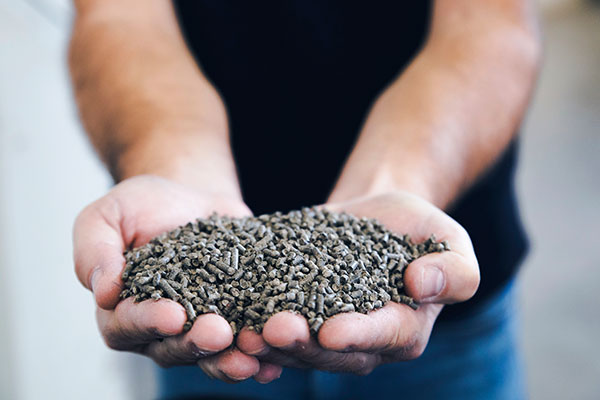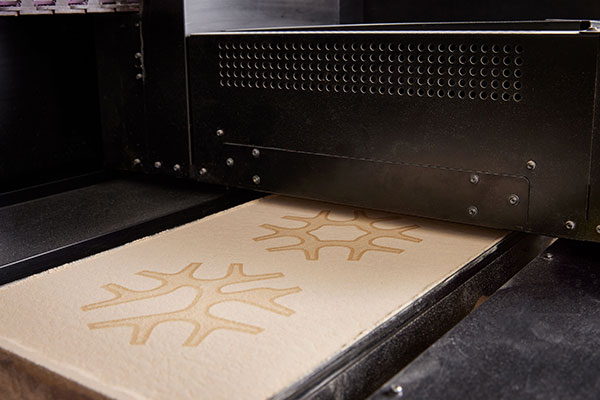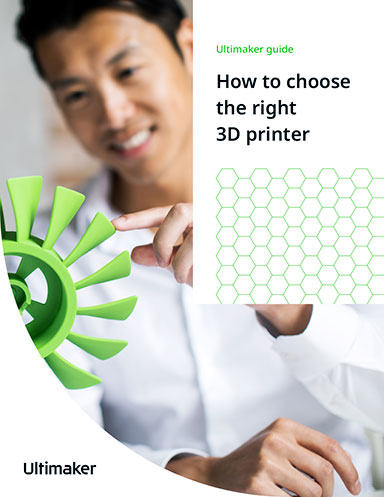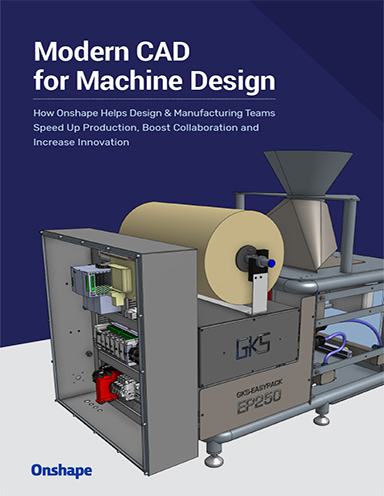Greening the 3D Printing Industry
New materials, optimized processes enhance AM’s already robust sustainability advantages.

UBQ Materials and Plastics App have teamed up to apply UBQ Materials’ sustainable thermoplastic to 3D printing filaments to tackle functional use cases like jigs, fixtures and spare parts. Image courtesy of UBQ Materials.
February 8, 2022
Sustainability has long been a part of the 3D printing story. But with heightened focus on environmental issues and the pandemic prompting a rethinking of global supply chains, the additive manufacturing (AM) industry is doubling down on efforts designed to emphasize the green benefits of 3D printing.
In an economy hungry for solutions that reduce waste, promote energy efficiency and streamline global supply chains, 3D printing has inherent advantages compared with traditional manufacturing methods. Regardless of the technology, 3D printing places material only where necessary as opposed to subtractive methods that machine or mill away material to create the desired end product—an approach that generates substantial waste.
As a discipline, 3D printing encourages sustainability in other ways: It focuses design thinking on lightweighting and parts consolidation and enables companies to reshape global supply chains around the promise of digital manufacturing. The latter promotes localized production, which saves on energy and transportation costs in addition to supporting on-demand output so manufacturers can substantially cut back on inventory of unnecessary or underutilized parts.
“Sustainability has been a huge part of additive manufacturing from the beginning and continues to be,” says Jonah Myerberg, CTO of Desktop Metal, a 3D printer manufacturer. “3D printing represents this interface between the digital and physical world where customers, engineers and manufacturers can leverage digital files to put products in the physical world directly. AM enables the digital factory of the future, which has a huge impact on the supply chain.”
In addition, Forust, a wholly owned subsidiary of Desktop Metal, is rematerializing wood waste to 3D print wood products.
Sustainable Lifecycle
Despite the long-standing environmental benefits of 3D printing, the industry as a whole has struggled to put a sustainability face on the technology, says Rosa Coblens, vice president of sustainability at Stratasys. The Additive Manufacturing Green Trade Association (AMGTA) was launched in November 2019 to change that equation, and Stratasys is now a founding member.
As a non-commercial entity, AMGTA is tasked with promoting environmental benefits of AM over traditional methods of manufacturing. Beyond educating the public and industry about the positive environmental benefits of 3D printing, AMGTA is also creating a set of best practices and is commissioning a series of reports and Lifecycle Assessment (LCAs) studies to quantify environmental impacts.
One such report, created in November 2020 by Dr. Jeremy Faludi from Delft University of Technology and Corrie Van Sice from Dartmouth College, presented a case that while metal AM was not necessarily a more sustainable way to manufacture basic metal parts, it had environmental benefits for producing finished precision components.
More recently, the AMGTA began work on an LCA that explores the sustainability of parts for specific aerospace applications. The trade group selected the Golisano Institute for Sustainability at Rochester Institute of Technology to conduct an LCA that would compare the cradle-to-grave environmental impacts of an additively designed and manufactured low pressure turbine (LPT) component to a traditionally manufactured component.
The study will include up to 18 environmental indicators to quantify the environmental impacts that an optimized jet engine LPT bracket has throughout its lifecycle—from material extraction, manufacturing and transportation to use and eventual end of life. This data will be compared to a traditionally designed and manufactured LPT bracket to determine where powder bed fusion AM technology results in lower environmental impacts.
AMGTA has also established a $100,000 fund at the Yale School of the Environment’s Center for Industrial Ecology to support research that examines AM’s sustainability benefits using LCA tools and modeling.
“The goal of this research is to understand the environmental and economic impacts of binder jetting compared to conventional manufacturing,” says Sherry Handel, AMGTA’s executive director. “Using LCA tools and modeling, the research will characterize impacts related to emissions of principal greenhouse gases and other associated impacts.”
AMGTA’s work is important because it opens up AM’s sustainability focus to more than carbon neutrality and emissions and considers the totality of a product lifecycle, says Stratasys’ Coblens.
“Companies talk about carbon neutrality and improving the process so less resources are consumed and there is less waste, but that’s really more about making incremental changes,” Coblens says, suggesting that getting engineers to connect AM to the ability to design for the environment from the earliest stages, favoring digital iterations over physical prototypes and making inventories more digital, can have far greater sustainability impact.
“Localized production, digital inventory—these are all very green elements of AM technology,” she says, acknowledging that it does takes time to shift companies’ perception and processes. “The industry needs to go through the deep process of data collection—we inherently know these things to be true, but we don’t have lifecycle analysis out there yet in a big data sense.”
Materials Move Front and Center
In addition to its membership in AMGTA, Stratasys is pursuing various other efforts aimed at promoting more sustainable AM.
The company invests in training and education efforts to teach engineers how to design products in more sustainably and has added new, organically sourced materials to its portfolio, including High Yield PA11. PA11 is 100% bio-based, made from castor oil.
For Desktop Metal, its investment and partnership with Forust is central to its sustainable materials story. The flexibility of AM technology, specifically binder jetting capabilities, enables the firm to experiment with non-traditional materials to improve its sustainability footprint.
The concept of Forust is to support additive rematerialization by repurposing waste streams from the paper and wood manufacturing industries—for example, sawdust and lignin—and turning them into lightweight wood components. The Forust process takes these byproducts and mixes them with a special bio-epoxy resin composite to create a sustainable material that can work with Desktop Metal’s binder jet technology.

Though initial use cases take aim at architects and designers of art and architectural applications, Forust has pushed the 3D-printed wood material and its processes to handle more load-bearing applications such as table and chair production in addition to some wood-grained finished parts for automotive applications.
The next step is to refine the Forust technology for structural architectural applications in addition to exploring new material possibilities using different types of scrap waste, Myerberg says.
“It’s our responsibility to make our machines capable of taking waste material from oceans and plastics, grinding them up, and turning them into materials you can print with,” he explains. “Binder jetting technology allows us to do that. We can develop the processes and machines that open up raw material supplies that already exist abundantly in nature.”
UBQ Materials, whose mission is to transform household waste into climate-positive thermoplastic materials, is set to bring its patented processes and materials to the 3D printing world.
The company has partnered with Plastics App, an R&D company that specializes in polymers and plastics, to launch a novel filament with a significantly reduced carbon footprint in an effort to promote more sustainable and eco-conscious manufacturing.
UBQ Materials converts unsorted waste slated for landfills into a climate-positive and cost-competitive thermoplastic that can substitute for oil-based resins. Plastics App has developed new filaments that incorporate UBQ’s materials, which can be used in a range of 3D printers for functional applications, from jigs and fixtures to 3D printing spare parts. The company is offering four types of carbon-reduced sustainable UBQ inside filaments to fit standard and demanding high-performance applications, officials say.
“We came across UBQ when developing conventional processing methods for materials for injection molding and extrusion,” says Dr. Yanir Shaked, founder and general manager of Plastics App. “We developed a formulation around UBQ to create functional parts,” and the filament can be used in widely available fused deposition modeling (FDM) and fused filament fabrication (FFF) 3D printers.
Sustainability is a key part of the Environmental, Social and Governance (ESG) initiative at 3D Systems. The environmental portion of the program includes a focus on identifying more sustainable options both within the company and for its customers. That includes eliminating waste and reducing carbon emissions.
A number of companies in the industry have also established material recycling programs.
Essentium, which focuses on systems and materials for large-scale AM, approaches sustainability in various ways. For one, the company focuses on process optimization, including enabling a high degree of parts nesting on the build platform to allow for more efficient machine operation in addition to supporting closed-loop processes on its servo motors. So if one system in the chain shuts off, the other connected platforms do the same to ensure energy is not idly wasted, explains Blake Teipel, Essentium’s CEO.
Additionally, all waste created from the raw materials used are captured and reintroduced as part of the platform’s processes. The company’s expansive materials library also features options that combine reground, out-of-spec materials with production-grade substances to support prototype 3D printing applications.
“We make sure we have a high recyclability content,” Teipel says.
Nexa3D is taking a holistic approach to sustainability with the design of its XiP desktop 3D printer. The printer housing and material canisters are built with aluminum, a recycled material, while packaging relies on plain cardboard and locally-sourced components.
From there, it’s all about digitizing the supply chain sustainably, from leveraging optimization to impact material and energy use at the onset of design to evaluating the cradle-to-grave implications of materials, including the way feedstocks are approached, formulations are made and recycled content is leveraged for production use.
“Ensuring that 3D printers and related equipment can be run energy efficiently while minimizing fume and VOC emission is vital to enhancing their place on the production floor,” says Avi Reichental, founder and chairman of Nexa3D. “We are in relentless pursuit of sustainable, ultrafast additive solutions that are good for humanity and the planet.”
More 3D Systems Coverage
Subscribe to our FREE magazine, FREE email newsletters or both!
About the Author
Beth Stackpole is a contributing editor to Digital Engineering. Send e-mail about this article to [email protected].
Follow DE





